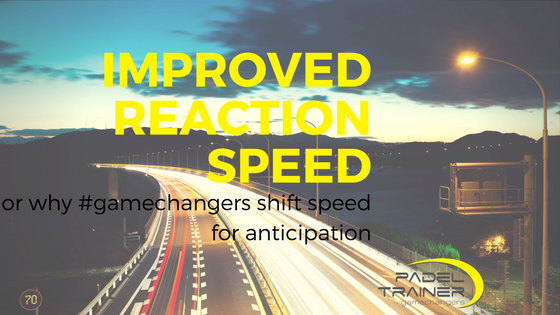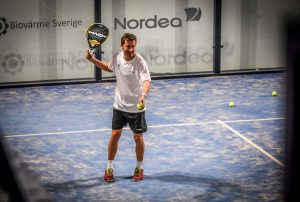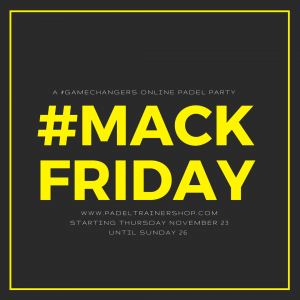When climbing the ladder of padel performance balls do fly at a much faster rate. It is so much difficult to anticipate in padel than in any other sport, given the simple fact that there are two of you anticipating at the same time. While coordination and communication is a must (six clues to help you decide who will be your game-changing padel partner) anticipation is key to improve your reaction speed.
Keep in mind that the faster your reaction will allow you to get faster to the ball. The point here is not only reaching it but reaching it having a plan that allows you to
- Make the right decision
- Balance yourself before the stroke
- Perform your stroke properly
So how can you improve your reactions in padel
? Here are four ways to shock your opponent’s with the not- so- expected returns. So once we know the what, we work on the how, and that is the reason we have taken the time to write this post. Our suggestion: Work out your plan in your mind, then DO take the time to comment and share with your padel bestie and try to come up with a “catalog” of responses you are both clear on.
Why is anticipation important?
Anticipation means that you predict what will happen with high probability. That is just the half of it. Making sure that your brain reads the signals of your opponent and deploys the right “program” in your body to execute it properly is the remaining half.
Say you are at the net and your partner returned the serve to your opponent. You can anticipate with high probability that your opponent will play the volley up and crosscourt, back to your partner on the baseline.
So before your opponent hits the ball, you already see what will happen and prepare your actions, in this case to attack the ball in advance.
Once your opponent makes his return, you can pounce immediately. For the outside observer, it may seem that your reactions are fantastic, but in fact, it was your anticipation what made that possible.
Anticipation is the real reaction
The real reaction has to do with you clearly seeing the situation and the ball. That is where anticipation becomes key factor. If instead of only narrowingly focusing on the ball as it travels toward your opponent, we open our mental space to notice and read the opponent´s body language as he or she prepares to hit the ball we would be able to prepare your self to respond more adequately to what is coming next.
This doesn’t have to do so much with anticipation of your opponent’s intention. Rather, it deals with sending all the available data from the situation to your brain, which will then be able to better decide what the right reaction should be.
Another problem is that the ball can suddenly change direction, going from you, towards the opponent, to the wall and then back to you. This sudden change of direction makes it difficult to track the ball, causing you to lose track of it for a split second. Your only option at that point is to react when you see the ball again and are able to determine its flight path, which can take a few hundredths of a second off of your reaction time.
In this case, the key is to switch your narrow focus from only the ball to the ball AND the opponent. Once your opponent hits the ball, you’ll get more cues on what kind of shot he played, and your eyes will be able to quickly and automatically find and track the ball.
It´s your attitude which guides your reaction. Your body is a physical expression of your attitude. Think about it, a relaxed physical attitude also plays a part in your reaction speed. If you are tense, you cannot react as fast because your muscles feel locked. Even though you see what is going on, your body doesn’t move immediately. The key is to stay alert and yet relaxed. The mind is focused and alert while the body is relaxed and ready to pounce. Again, its all a brain game
The Footwork is crucial for anticipation.
Every sport that demands quick reactions and movement to the ball has a split-step. A soccer goalie makes a split-step before moving to the ball. The same applies to a handball goalie (but the split-step is very low), and to a volleyball player who reacts to the spike. A split-step allows you to store the energy in your legs BEFORE the actual stroke. This is a whole chapter for padel players for whom footwork is an essential.You´ll see this pointed out through our video tutorials (click here to check basic footwork training)
But if you store the energy too early it will dissipate. If you stay low with bent knees for a second, you cannot move as fast as if your knee bend was just a quick bounce. So it is important to keep moving, bouncing and jumping while reading your opponents move. It will keep the energy in your legs ready to explode.
Timing is of the essence. You need to reach the exact spot the instant you realize where the ball is going. That means that you have to split-step just before your opponent makes contact. How early? Even if we explain that here, it won’t help you. You need to practice and FEEL when it’s the right moment to react and push towards the ball the fastest.
You can, of course, spend some time working on improving reactions in padel, but in our experience, you’ll improve more by learning to anticipate what’s about to happen. Once you are able to predict better, you’ll also react better. See you at court,
The Padel Trainer team




